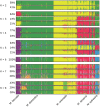New insight into the history of domesticated apple: secondary contribution of the European wild apple to the genome of cultivated varieties
- PMID: 22589740
- PMCID: PMC3349737
- DOI: 10.1371/journal.pgen.1002703
New insight into the history of domesticated apple: secondary contribution of the European wild apple to the genome of cultivated varieties
Abstract
The apple is the most common and culturally important fruit crop of temperate areas. The elucidation of its origin and domestication history is therefore of great interest. The wild Central Asian species Malus sieversii has previously been identified as the main contributor to the genome of the cultivated apple (Malus domestica), on the basis of morphological, molecular, and historical evidence. The possible contribution of other wild species present along the Silk Route running from Asia to Western Europe remains a matter of debate, particularly with respect to the contribution of the European wild apple. We used microsatellite markers and an unprecedented large sampling of five Malus species throughout Eurasia (839 accessions from China to Spain) to show that multiple species have contributed to the genetic makeup of domesticated apples. The wild European crabapple M. sylvestris, in particular, was a major secondary contributor. Bidirectional gene flow between the domesticated apple and the European crabapple resulted in the current M. domestica being genetically more closely related to this species than to its Central Asian progenitor, M. sieversii. We found no evidence of a domestication bottleneck or clonal population structure in apples, despite the use of vegetative propagation by grafting. We show that the evolution of domesticated apples occurred over a long time period and involved more than one wild species. Our results support the view that self-incompatibility, a long lifespan, and cultural practices such as selection from open-pollinated seeds have facilitated introgression from wild relatives and the maintenance of genetic variation during domestication. This combination of processes may account for the diversification of several long-lived perennial crops, yielding domestication patterns different from those observed for annual species.
Conflict of interest statement
The authors have declared that no competing interests exist.
Figures





References
-
- Diamond J. Guns, Germs, and Steel: The Fates of Human Societies. Norton, W. W. & Company, Inc. Sales; 1997.
-
- Zeder MA, Emshwiller E, Smith BD, Bradley DG. Documenting domestication: the intersection of genetics and archaeology. Trends Genet. 2006;22:139–155. - PubMed
-
- Diamond J. Evolution, consequences and future of plant and animal domestication. Nature. 2002;418:700–707. - PubMed
-
- Purugganan MD, Fuller DQ. The nature of selection during plant domestication. Nature. 2009;457:843–848. - PubMed
-
- Wright SI, Gaut BS. Molecular population genetics and the search for adaptive evolution in plants. Mol Biol Evol. 2005;22:506–519. - PubMed
Publication types
MeSH terms
LinkOut - more resources
Full Text Sources

